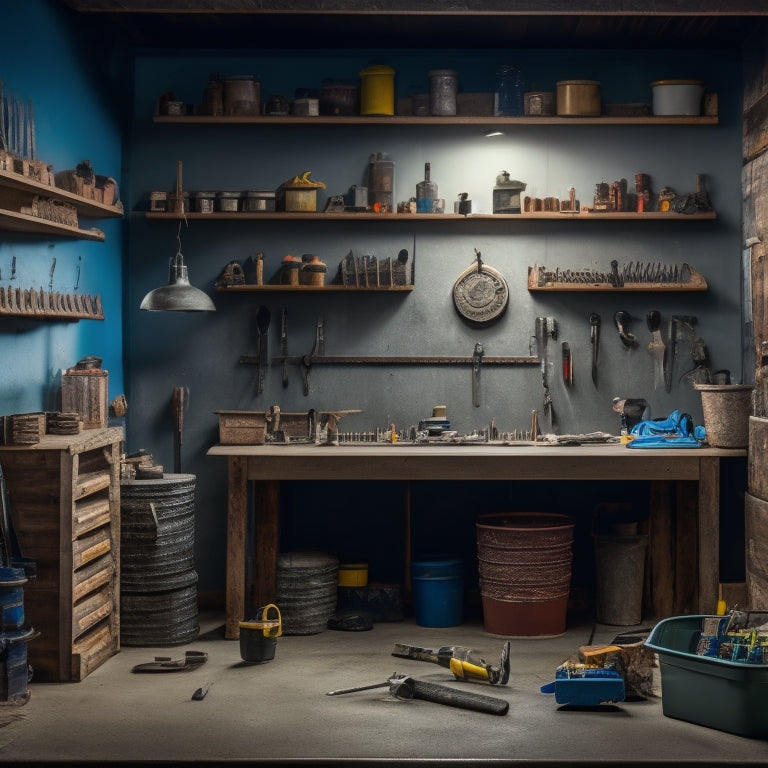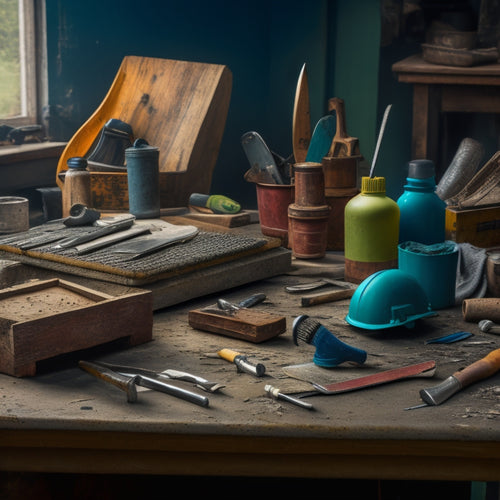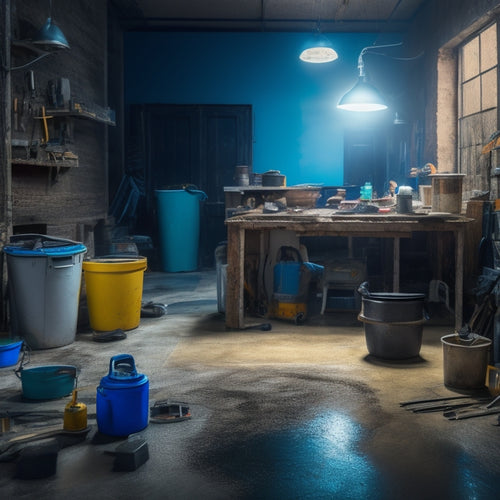
Organize Your Tools for Concrete Laying Success
Share
To guarantee concrete laying success, you need to organize your tools efficiently. Allocate a dedicated area for tool storage, labeling each spot for easy access. Invest in sturdy tool chests or cabinets with separate compartments to prevent downtime from searching for misplaced tools. Customize your storage system to fit specific tools, and avoid stacking to prevent moisture-trapping pockets. With a well-organized system, you'll reduce time wasted searching for tools and increase productivity. By implementing these strategies, you'll be well on your way to streamlining your workflow and achieving concrete laying success - and that's just the foundation of what you can accomplish.
Key Takeaways
• Allocate a dedicated area for tool storage to maintain efficiency and prevent downtime.
• Use modular storage compartments with labeling and signage for quick tool identification and access.
• Implement a mobile storage system, such as a toolbox on wheels, for easy access to essential tools and equipment.
• Protect tools from damage by regularly cleaning and maintaining them, and storing them in dry locations.
• Designate a 'launching pad' for crew organization and strategically place tools and materials for easy access to enhance job site efficiency.
Essential Tool Storage Considerations
When setting up your concrete laying workspace, prioritize allocating a dedicated area for storing your tools to maintain efficiency and avoid downtime. You don't want to be stuck searching for a misplaced trowel in the middle of a pour, do you?
Designate a specific spot for your tool inventory, and make sure it's easily accessible. This will save you time and energy in the long run.
Consider the type of storage materials you'll need. Metal or plastic bins, shelves, or hooks can help keep your tools organized and protected from the elements.
Label each storage unit so you can quickly identify what's inside. This is especially important if you have a large tool inventory or multiple workers on site.
Designing a Block Laying Station
Set up a block laying station that streamlines your workflow by positioning all necessary materials and tools within easy reach, allowing you to focus on laying blocks efficiently and accurately. Think of it as your concrete command center!
A well-designed station helps you stay organized, saves time, and reduces frustration. Start by identifying the essential tools and materials you need for the job, such as trowels, levels, and block adhesive.
Next, consider the block layout and workspace design. Arrange your tools and materials in a way that makes sense for your workflow. For example, place your trowels near the block piles and your levels near the mixing area. Don't forget to leave enough space to move around comfortably. A cluttered station can lead to mistakes and accidents.
Mobile Storage for Concrete Tools
When you're working on a concrete laying project, you know how important it's to have your tools within easy reach.
That's where mobile storage comes in - it helps you stay organized and efficient on the job site.
Toolbox on Wheels
You'll find a toolbox on wheels to be an indispensable asset on your concrete laying site, as it keeps all your essential tools and equipment within easy reach and organized. This mobile storage solution is a game-changer, allowing you to tackle tasks efficiently and effectively. With mobility features like sturdy wheels and a compact design, you can effortlessly move your toolbox around the site to where the action is.
Here are some key benefits of a toolbox on wheels:
| Feature | Benefit |
|---|---|
| Tool Durability | Protects your tools from damage and extends their lifespan |
| Easy Access | Saves time searching for tools, reducing downtime and increasing productivity |
| Space-Saving | Compact design maximizes storage capacity, keeping your site clutter-free |
Tool Organization Systems
By investing in a well-designed tool organization system, you can transform your concrete laying workflow, guaranteeing that every essential item has its designated place and is readily available at a moment's notice.
This means no more scrambling around the job site, searching for that one specific trowel or level. With a solid tool organization system in place, you'll be able to focus on the task at hand, rather than wasting precious time searching for misplaced tools.
Here are a few key features to look for in a tool organization system:
-
Modular storage compartments to keep your tool inventory tidy and easily accessible.
-
Labeling and signage to guarantee you can quickly identify where each tool is stored.
-
Adjustable shelving and dividers to accommodate tools of varying sizes and shapes.
Labeling and Signage Strategies
Establishing a labeling and signage system helps you quickly identify concrete laying tools and materials, saving time and reducing errors on the job site. It's like having a personal assistant pointing you in the right direction, minus the attitude and coffee breaks. With a solid labeling and signage strategy, you'll be able to:
| Labeling Techniques | Signage Visibility | Benefits |
|---|---|---|
| Color-coding | High-contrast colors | Easily distinguish between tools and materials |
| Barcode scanning | Large font sizes | Reduce errors and increase efficiency |
| Tool categorization | Clear icons and images | Simplify tool identification and location |
| Material labeling | Reflective signage | Improve visibility in low-light conditions |
| Custom signage | Personalized labels | Enhance organization and professionalism |
Protecting Tools From Damage
When you're working with concrete, your tools are constantly exposed to harsh conditions that can cause damage.
To keep your tools in top shape, you'll need to store them properly and take steps to prevent rust from forming.
Tool Storage Options
You'll want to invest in a sturdy tool chest or cabinet with separate compartments to protect your concrete laying tools from damage and keep them organized. This is essential because you don't want your tools getting rusty or damaged, which can lead to costly repairs or even worse, having to replace them altogether.
When choosing a tool storage option, consider the following:
-
Shelf design: Look for shelves with a slanted design to prevent tools from falling off. This is especially important for heavy tools like trowels and floats.
-
Storage materials: Opt for storage materials that are durable and resistant to moisture, such as metal or high-quality plastic. Avoid materials like wood, which can warp or rot over time.
-
Customization: Consider a storage system that allows you to customize the compartments to fit your specific tools. This will guarantee that each tool has its own designated spot, making it easier to find what you need when you need it.
Prevent Rust Formation
To prevent rust formation and damage, regularly clean your concrete laying tools with a wire brush and dry them thoroughly, paying extra attention to crevices and areas where moisture can accumulate.
You don't want your tools to turn into rusted relics, do you? Next, apply rust inhibitors to vulnerable areas to provide an extra layer of protection.
For added security, store your tools in a dry location or use moisture barriers to keep the dampness at bay. Remember, rust loves moisture, so keep them apart like feuding neighbors.
When storing tools, avoid stacking them on top of each other, as this can create moisture-trapping pockets. Instead, hang them or lay them out in a single layer.
Accessibility and Ergonomics Matter
Concrete laying can be a physically demanding task, and having accessible tools and ergonomic equipment can greatly reduce fatigue and discomfort.
You're not getting any younger, and those creaky joints won't fix themselves! By prioritizing tool accessibility and ergonomic design, you'll be able to work smarter, not harder.
Here are a few ways to get started:
-
Tool stations: Set up designated areas for frequently used tools, keeping them within easy reach to minimize bending and stretching.
-
Ergonomic handles: Invest in tools with comfortable, cushioned grips that reduce strain on your hands and wrists.
-
Adjustable heights: Use workbenches or tables with adjustable heights to guarantee you're working at a comfortable level, reducing strain on your back and neck.
Adaptable Storage for Specialized Tools
Storing specialized tools in adaptable containers saves time and reduces frustration when switching between tasks or projects. You know the drill - you're in the middle of a concrete laying job, and you need to swap out your edger for a trowel. With adaptable storage, you can quickly grab what you need and get back to work.
Modular storage systems are a game-changer here. They let you customize your tool storage to fit your specific needs, so you can access what you need in a flash. Imagine having all your specialized tools within arm's reach, neatly organized and easy to find. It's a beautiful thing!
By investing in adaptable storage, you'll reduce the time you spend searching for tools and increase your productivity. Plus, you'll be less likely to misplace expensive equipment or damage it due to poor storage.
With adaptable storage, you'll be the master of your concrete laying domain, and your tools will be happy and healthy too!
Maximizing Job Site Efficiency
By streamlining your workflow and eliminating unnecessary steps, you can maximize job site efficiency and get the job done faster.
Think of it like a well-choreographed dance – every move counts, and every second wasted is a step backward.
To optimize your workflow, take a closer look at your job site layout. Are your tools and materials strategically placed for easy access? Are there any bottlenecks or chokepoints that slow you down?
Here are a few strategies to boost your job site efficiency:
-
Designate a 'launching pad': Designate a centralized spot for your crew to gather, gear up, and get to work. This can be a trailer, a tent, or even just a marked-off area.
-
Implement a 'clean as you go' policy: Encourage your team to tidy up as they work, reducing clutter and tripping hazards.
-
Schedule regular 'tool timeouts': Set aside time each day to inspect, maintain, and restock your tools, ensuring they're in top condition when you need them most.
Frequently Asked Questions
Can I Store My Tools in a Humid Environment?
You're wondering if you can store your tools in a humid environment? Well, let's just say it's not the best idea, but it's not a total no-go either.
To prevent tool rust, you'll need to implement some humidity control techniques, like using silica gel packets or a dehumidifier. You can also apply a rust-inhibiting coating to your tools.
With a little extra effort, you can keep your tools safe from the moisture monster and guarantee they're always ready for action!
How Often Should I Clean and Maintain My Tools?
You're wondering how often to clean and maintain your tools?
Well, let's get real, you don't want to be that guy who's stuck with rusty, crusty tools that are more likely to hinder than help.
For tool longevity tips, aim to clean and maintain them every 1-3 months, depending on usage.
Daily wipe-downs and weekly deep cleans can make all the difference in maintenance frequency.
Trust us, your tools (and your concrete-laying skills) will thank you!
Are There Specific Tools for Different Types of Concrete?
You're wondering if you need a separate toolkit for different types of concrete?
Well, yes and no!
You'll definitely need specialized concrete mixing tools for specific jobs, like a mixer for large batches or a trowel for small areas.
But, when it comes to finishing tools, you can get away with using the same ones for most types of concrete.
Just remember, it's like baking a cake - you need the right ingredients (tools) to get the desired finish!
Can I Use Makeshift Tools for Concrete Laying?
Can you get by with makeshift tools for concrete laying?
Well, you're not gonna win any awards for 'most efficient' or 'highest quality,' but you can make do in a pinch. Just don't expect exceptional results.
The effectiveness of makeshift tools depends on your concrete laying techniques - and let's be real, your level of desperation.
If you're in a bind, go for it, but for a professional finish, invest in the real deal.
Are There Any Specific Tool Storage Regulations to Follow?
You're wondering if there are specific tool storage regulations to follow? Well, you're on the right track!
Tool safety is key, and storage guidelines are essential to avoid injuries and damage.
Make sure to store heavy tools at the bottom, keep sharp objects separate, and label everything.
Don't be that person who trips over a misplaced trowel - follow the rules and keep your workspace tidy!
Conclusion
As you wrap up your concrete laying project, remember that a well-organized tool setup is the backbone of success.
With a solid storage system in place, you'll be like a conductor leading an orchestra - every tool in harmony, every movement efficient.
By following these tips, you'll strike the right chord, maximizing job site efficiency and paving the way for a flawless finish.
Related Posts
-

Must-Have Handheld Tools for Concrete Repair
When tackling a concrete repair project, it is crucial to have the right handheld tools to achieve a professional fin...
-

Essential Tools for Epoxy Concrete Floor Repair
You'll need a thorough arsenal of specialized tools to guarantee a successful epoxy concrete floor repair. Floor prep...
-

Free Design Tools for Concrete House Planning
You can kick-start your concrete house planning project without breaking the bank, as there are several free design t...


